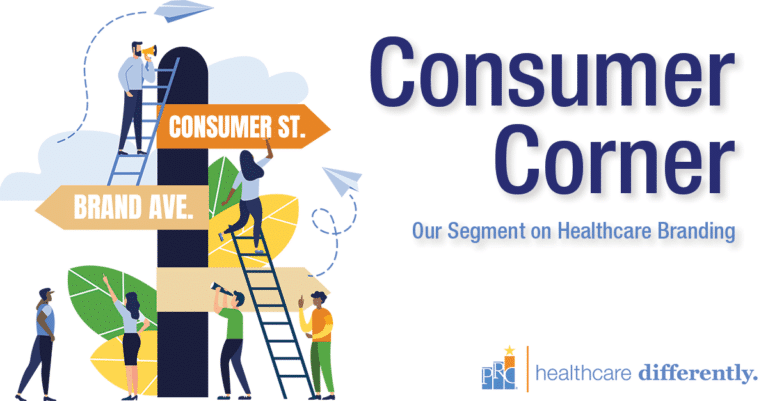In our virtual world, many professionals have logged off a Microsoft Teams call and received the note: “How was your call quality?” Consumer feedback is important in nearly every service of our day-to-day. Making data-driven decisions means making educated decisions. We all feel we have good common sense and gut instincts, but we’re not the only ones whose instincts must be considered. As professionals in any industry, we must understand how certain populations feel towards our service to ensure we are providing what they want and need.
In a world of noise and online analytics, our goals can be lost in the haystack of data. An important question to pose to leaders: What data should we be analyzing? It can be fun to see the number of reactions the viral cat video pulled in overnight or count the empty coffee cans stacking up at the nurses’ station. However, those numbers don’t relate to the consumer perception of your specific brand. While certain statistics, such as demographics, can describe your customers, gathering perceptions and behaviors directly from a consumer’s tongue is equally important.
The Obvious
Whether we’ve noticed it or not, as members of society, we have all seen customer satisfaction surveys. This feedback loop takes camouflage as survey links at the bottom of a receipt, a QR code on a card at a table in a restaurant, a follow-up email after a visit to an establishment, or even a “Tell Us How We Are Doing” sign posted. Customers are the lifeblood of any organization and it seems obvious to most to capture their input.
Another obvious insight stems from employee experiences. Every organization wants to be listed as a great place to work. Without great staff, you cannot provide excellent products and services. The press on retention proves it’s more expensive to constantly train new staff than to keep great employees long-term. Capture the voice of your experienced members to maintain quality and improve financial burdens.
The Required
In the healthcare world, some of the previously mentioned types of data collection are required due to their importance. CMS requires hospitals who bill Medicare through the Inpatient Prospective Payment System to conduct HCAHPS surveys. These HCAHPS surveys hold hospitals accountable for putting their best foot forward in the care they provide. Similarly, all not-for-profit hospitals must conduct a Community Health Needs Assessment (CHNA) to adopt an implementation strategy every three years to maintain their status according to IRS Section 501(c)(3) requirements. These assessments are required by the government to ensure hospitals do everything they can to benefit the community.
Commitment or Commodity?
All customers are consumers, but not all consumers are customers. There are people within your community who may use the products and services you offer, but don’t necessarily use your organization. In addition to gaining feedback from your customers, it is equally important to your brand to understand the perceptions of the general consumer in your market. Unfortunately, input from this group is often forgotten.
As outlined, where other types of data are required, Consumer & Brand surveys may be treated by some as a commodity. Understanding the voice of your consumer can be thought of as “nice to have” but “not necessary.” In reality, however, it is extremely important to the health of an organization to understand how the community-at-large perceives the healthcare options in their community. In other industries, the commitment to offering the best service possible can only be achieved by understanding what the market recognizes as best.
Often, healthcare leaders equate brand perception data to their marketing campaigns’ success. While price, product, place, and promotion certainly play a role in decision-making, there is so much more that goes into the lasting impression your brand leaves on your community.
As marketing leaders, we understand the power of word-of-mouth, for better or worse. When a customer receives poor service, they shout their bad experience from the rooftops and stir up community conversation. Similarly, when they receive exceptional service, the positive word is spread but details can be left out. Conducting solely “the required” surveys may reveal great PX scores, but the translation to the local gossip mill may be construed. Merely assuming positive word-of-mouth could hinder your marketing tactics. With fact-proven data, consumer and brand research can help you identify commonality or disconnection between how your patients feel today, and how the overall community feels about you.
Additionally, consumer and brand surveys reveal insights for rising above the competition. You may provide “good” care, while your neighbor next door is providing care perceived as “excellent.” With a commitment towards offering the best experience, you must explore what your community rates as best. Multiple factors outlined in this research can expose these truths such as: ease of location, perceived better care, or in general, cleanliness. Consumer and brand studies allow you to find out how people make decisions, what is important to them, why they prefer their chosen hospital, how they choose their doctor, and what factors are most important when looking for a new healthcare option. This information is generally not found in other types of studies, begging a re-evaluation of the question, “Commitment or Commodity?”
Ready, Set, Go!
By now, you may be asking, ‘When should I start collecting consumer perceptions?” For starters, if you haven’t collected this data in the past, you should establish a benchmark to find out how your community feels about you and your competition. Once collected, reflect on the numbers and the parallels or conflicts revealed between the perceptions of your patients and the community. The fact is, if the foundation of care is not there, you are not yet marketing-ready and need to focus efforts on strengthening your patient experience. If your patient experience is strong, but we find a disconnect with your community, we know you have a marketing opportunity. If your patient experience scores are strong and your consumer and brand data is positive, we know to continue the current trajectory.
No matter how any of your other data looks, understanding how the community feels is more than a commodity. It is a necessary practice to ensure your brand is as strong as it can be.
To learn more about how PRC can help measure the strength of your brand, please contact us at [email protected] or fill out the form below.
About the Author
Keith Schneider
Director, Consumer & Brand
Joining PRC in 2002 with a lifelong passion for branding, Keith employs a deep-seated set of marketing and research skills to help clients obtain actionable insights that will enable them to make strategic decisions to deliver quality care in ways that elevate their brand. During his tenure at PRC, Keith has managed hundreds of complex, custom research projects for healthcare organizations throughout the United States, overseeing the sample design stages, script-writing functions, and sample generation for PRC’s computer-aided telephone interviewing system as well as electronic surveys. Through timely deliverables and engaging, informative presentations, Keith helps ensure that clients have the data they need to assess their image, interpret the findings and fulfill all their research objectives. He currently leads PRC’s Consumer & Brand division and guides custom research to enhance clients’ marketing and branding efforts. Keith earned a Bachelor of Science degree in Business Administration from the University of Nebraska–Omaha.


